Thursday, April 5, 2012
Small Japanese covered containers 珍味入れ
Last time we were in Kyoto, somehow we ended up in the Nishiki Market 錦市場 early in the morning. Many stores just opened or were getting ready to open up. My wife spotted a small china store. The middle aged man, who apparently was the owner, was still unpacking the items in front of the store. He had a very extensive collection of small covered containers which Japanese like to use to serve a small portion of "extraordinary tastes" or "chinmi" 珍味. He even unpacked more of these containers for her. These are six she chose (I sanctioned the limit to 6). Some are spheres with a concetric ring pattern or with plum flowers. She chose two of the spheres with concentric ring pattern since she really liked it. She chose one of each for others. The owner said this happened to be the most popular item and praised my wife's keen eye and good taste but I had a feeling if she liked other container he would have made that one most popular. In any case, we hand carried all these contianers and boxes home on the airplane. Somehow, I completely forgot that we had this. I was pleasantly surprised when I found them in the back of the cupboard.

Nothing new here, but I served squid marinated in mirin and soy sauce or "Okizuke" 沖漬け(left), Ikura salmon roe in cucumber cup and garnished with salted kelp (center) and "mozuku" sea weed in sweet vinegar (right). All prepackaged, I just thawed and arranged.
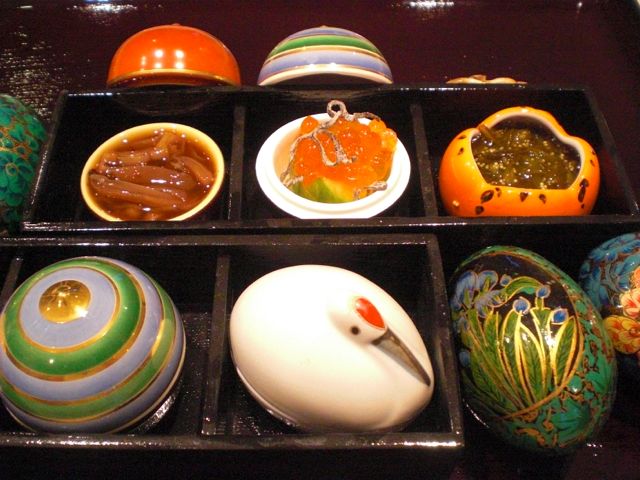
These are nice containers to have, especially if you are into serving drinking snacks for sake like we are. Only problem is that all these containers need to be hand washed and it is easy to break (we have not, yet). By the way, the picture shows some lacquered easter eggs that my wife collected. She thought they were seasonal and added them to the picture.
Tuesday, April 3, 2012
Roasted Brussel sprout salad ロースト芽キャベツのサラダ
When I lived in Japan, I never noticed Brussel sprout or Brussels Sprout being sold at the market but obviously these are available in Japan now. My understanding of Brussel sprouts is that they are the side buds of a certain cultivar of wild cabbage. (If this vegetable is named after the capital of Belgium, this should be called "Brussels sprout", but the vast majority of cookbooks and grocery stores in the U.S. list it as "Brussel sprout"). My first encounter with this vegetable was at a Christmas dinner after I came to the U.S. My wife has cooked Brussel sprouts in several different ways and, (even) I tried a few recipes but none was satisfactory. So it remained a must-have-for-Christmas-dinner-but-nobody-ate-it side dish. That was until my wife decided to roast them until the surface blackens. This is absolutely the best way to cook and enjoy Brussel sprouts and now we make this regularly with other roasted vegetables such as greenbeans, carrot, onions, and cauliflower. The roasted Brussel sprout, when it first comes out from the oven, has a nice blackened and crispy outer layer with sweet creamy inside.

I even use leftover roasted Brussels sprouts in our sandwiches (sliced, of course). One day, we found only a few leftover roasted Brussel sprouts in the fridge. By my wife's suggestion, I made them into a small salad.
For 4 small servings such as the one shown above; roasted Brussel sprout (6 halved or quartered depending on its size), apple (one Honey crisp or other sweet and sour crisp apple, skinned and cut into small chunks), Campari tomato (4, skin removed and quartered), cucumber (one minicucu, soft center removed and cut into small chunks).
Dressing: I mixed store bought mayonaise (1 tbs), plain yogurt (1 tbs), Dijon mustard with horse raddish (2 tsp), salt and black pepper.
I served this on the bed of baby spinach. This was a good starter dish. Brussel sprouts and apple go very well together. The contrast between the crisp apple and soft and sweet Brussel sprout was supported by tangy but creamy dressing.
Sunday, April 1, 2012
Lamb loin chops with reduced red wine sauce with garlic and mint flavor 子羊肉の赤ワインソース
Did I tell you my wife likes lamb very much. Although lamb is not a popular meat in Japan (especially in the old days when I lived there), it was widely enjoyed by Hokkaidian 北海道人. The dish is called "Genghis Khan" nabe or "Jingisukan-nabe"*. This may be because livestock production including dairy and raising sheep is very big in Hokkaido. (You may recall the famous sheep hill in Sapporo).
* The old Sapporo beer brewery was converted into a cavernous "beer garden" with all-you-can-eat Jingiskan grill. (Now, I learned that it was fruther converted into a beer museum with an adjacent restaurants). Since I knew my wife liked lamb, I took her there. Jungiskan nabe is a convex cast iron grill with ridges and grooves on which rolled and thinly sliced mutton/lamb is grilled.
Since the Japanese, in general, do not like the true flavor of mutton or lamb, they do everything and anything to cover it up with either strong marinades (before cooking) or dipping sauce after cooking--or both. As a result, my wife's review of the dish was, "You say this is made of lamb? I couldn't tell, all I tasted was soysauce".
One week end, we cooked loin chops of lamb which may not be the most popular cut of lamb but the meat is tender and tasty. Since I had a bottle of Bordeaux which did not meet our lowest drinkability standard, I also made reduced red wine sauce with garlic and mint.
I served this with a side of baked greenbeans and parmesan couscous (from the box, just add chicken broth, a pat of butter. When it comes to a boil, add couscous, remove from heat and let it stand for 5 minutes. Fluff with a fork).
I served this with a side of baked greenbeans and parmesan couscous (from the box, just add chicken broth, a pat of butter. When it comes to a boil, add couscous, remove from heat and let it stand for 5 minutes. Fluff with a fork).
I sliced garlic cloves (3-4). I fried the garlic in olive oil (2 tbs) in low heat until the garlic was fragrant, slightly browned, and the garlic flavor transfered to the oil. I seasoned the lamb loin chops (4) with salt and pepper. Using the garlic infused oil, I seasoned and browned both sides finishing them in 350F oven for 5-8 minutes.
I removed the meat and set it aside on the plate loosely covered with aluminum foil. While the meat was resting, I made a sauce. I blotted the excess oil from the pan using a paper towel and put the pan back on the medium flame. I deglazed it with red wine (happend to be Bordeaux, about 1/2 cup) and added back the garlic. After it reduced in half, I added Balsamic vinegar (1 tbs) and further reduced the mixture (final amount was just coating the bottom of the pan). I added back any juice accumulated in the plate where the lamb chops were resting. Since I realized I am out of fresh mint, I just added dried mint leaves (1/2 tsp).
A good Austrarian shiraz (maybe MollyDooker BlueEyed boy) is a good match but I think we had this with California Cab (I do not remember which one).
(From http://www.japan-guide.com/e/e5300.html)* The old Sapporo beer brewery was converted into a cavernous "beer garden" with all-you-can-eat Jingiskan grill. (Now, I learned that it was fruther converted into a beer museum with an adjacent restaurants). Since I knew my wife liked lamb, I took her there. Jungiskan nabe is a convex cast iron grill with ridges and grooves on which rolled and thinly sliced mutton/lamb is grilled.
Friday, March 30, 2012
Grilled black sea bass with grilled asparagus and shiitake mushroom ブラックシーバスの塩焼き
After hanami, the weather turned more seasonal (cooler) but it was still nice enough to grill outside. One weekend, we bought a whole black sea bass and decided to just simply grill it on the charcoal fire. At the market, there were few fresh whole fish available, Arctic char and black sea bass looked good to me and I chose black sea bass since we eat salmon frequently and char is somewhat similar to salmon. This black sea bass was a good sized fish.
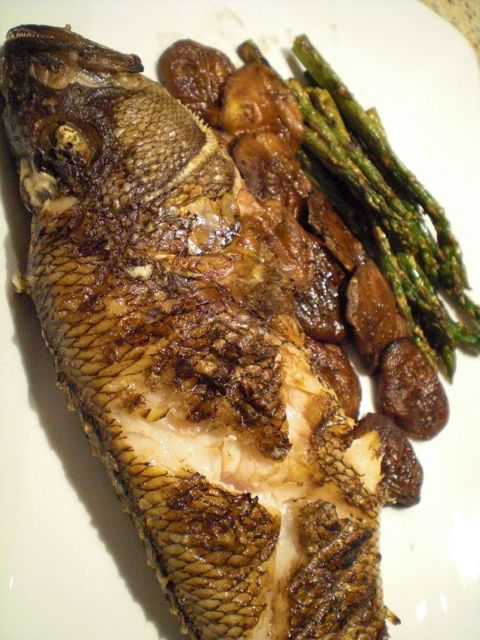
What is the Japanese equivalent of black sea bass? I am not sure but I could not find similar Japanese fish. Thus, the Japanese phonetic expression of "black sea bass" ブラックシーバス appears appropriate. It is a white meat fish but has nice firm sweet meat. It can be grilled, fried, simmered and is available as a sashimi item in sushibars. I did not think, however, that this was fresh enough for that.
 Black sea bass: This was about 13 inches long. I had it gutted, scaled and the dorsal fin removed (very spiky) by the fish monger. I decided to simply salt it and grill it without further embellishment. I made shallow cross cuts on both sides of the fish to prevent the skin from rupturing during grilling. I salted inside and out a few hours before grilling, covered and put it in the refrigerator. Just before grilling, I patted the skin dry with a paper towel and smeared light olive oil on the skin (mostly to prevent the skin from sticking to the grill).
Black sea bass: This was about 13 inches long. I had it gutted, scaled and the dorsal fin removed (very spiky) by the fish monger. I decided to simply salt it and grill it without further embellishment. I made shallow cross cuts on both sides of the fish to prevent the skin from rupturing during grilling. I salted inside and out a few hours before grilling, covered and put it in the refrigerator. Just before grilling, I patted the skin dry with a paper towel and smeared light olive oil on the skin (mostly to prevent the skin from sticking to the grill).
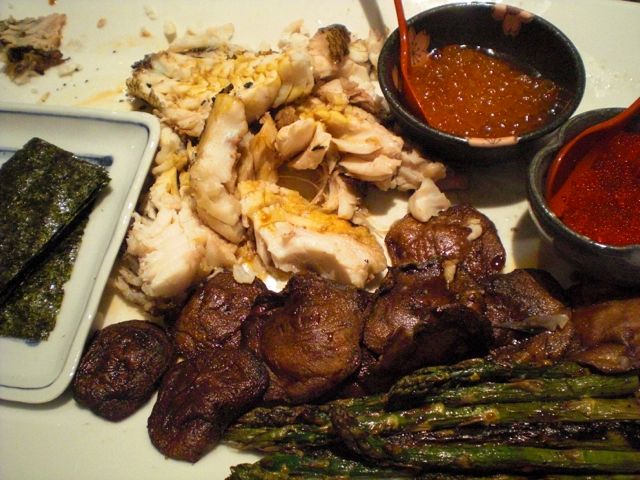
Vegetables: I grilled fresh shiitake mushrooms and aspragus at the same time. For the shiitake mushrooms, I removed the stem. For the asparagus, I removed the woody root ends. I coated them with olive oil and seasoned both with salt and pepper.
Grill preparation: I used slightly less lump charcoal than I usually use--(about 80% of what I would use to roast a whole chicken). I ignited the charcoal using a chimney charcoal starter. After the charcoal was ready, I just dumped in on the bottom grate of the Weber grill in an oval-shaped mound corresponding with the shape of the fish with the center portion having few layers and the periphery less charcoal so that the fish get hottest fire and the vegetables less so. I cleaned and sprayed the grill grate with a non-flammable non-stick oil spray.
I placed the fish on the grill, put on the lid but left both bottom and top air vents fully open. I let it cook for 5 minutes and then placed the mushrooms and asparagus on either side of the fish. After another 5 minutes, I turned over the shiitake mushrooms and moved them further away from the hot charcoal to prevent charring (my wife does not like "blackened" mushrooms i.e. mushrooms with burned sections). I also turned the asparagus but left them in the rather hot area of the grill next to the fish. I flipped over the fish trying not to damage the skin. I cooked another 5 minutes with the lid on. I thought the fish was just done but my wife who peeked into the flesh said it was still transparent near the bone. I had to put the fish back for another 5 minutes to complete the cooking.
My wife deboned the fish and separated the meat as you see above. We shared this plate. We had this with a bowl of white rice. I also served "Ikura" salmon roe, "Tobiko" flying fish roe, and seasoned nori or "Ajitsuke nori". This was very enjoyable and we finished up the entire fish. The meat was a bit overcooked but still quite nice. The shiitake mushroom was succulent and almost tasted like meat with a nice smoky flavor (and I did not burn them this time).
Wednesday, March 28, 2012
Udon noodle in hot broth かけうどん
This is again not blogworthy but a perfect ending dish or light lunch. I found a unopened package of dried udon うどん noodle in the pantry. The date of "best used by" had expired by few months. I thought I better use it quickly.
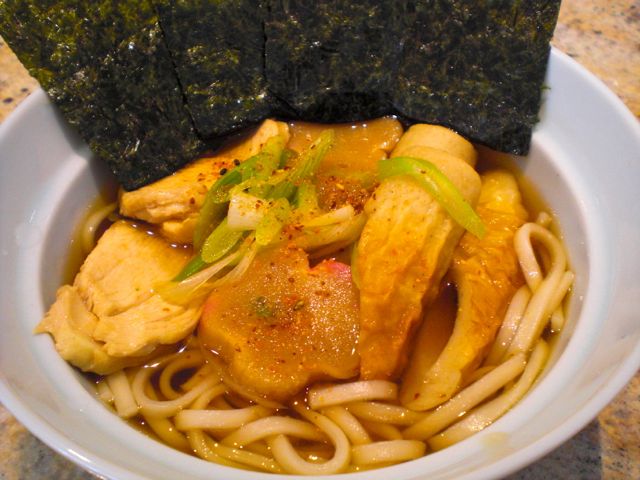
Udon is a type of Japanese noodle made of wheat flour. The ones we can get here is either frozen or dried. Of course, you could make it from scratch if you so prefer. I have posted hand-made udon by Chef Kitayama of Sushi-taro.
Udon can be eaten many ways; simmered in broth ("Nikomi" udon 煮込みうどん), in hot broth ("Kake" udon かけうどん), cold or hot with a dippin sauce ("Zaru" udon ざるうどん or "Kama-age" udon 釜揚げうどん), cooked in a small individual earthen pot ("Nabeyaki" udon 鍋焼きうどん) etc. Depending on the topping, it may be called differently such as Kitusne udon きつねうどん (with deep fried tofu pouch), Tanuki udon たぬきうどん (with bits of deep fried tempura without other items), "Tsukini" udon 月見うどん (with a raw egg), "Karei udond" カレーうどん(with curry sauce) etc.
The day I made this I had a leftover broth which was made with a dashi pack in the refrigerator. I added mirin, sake, and soy sauce to taste (I am not sure about the amount but I had about 3 cups of broth and I added 2 tbs each. And after tasting it I added more soy sauce).
For basic "kake" udon, only chopped scallion will be the topping but I added whatever I had. I had sake steamed (microwaved) chicken breast, frozen fish cake or chikuwa 竹輪, and "kyo-b(f)u" 京麩. "Fu" 麩 is made of 100% wheat gluten, so if you have gluten sensitive enteropathy, Celiac disease, or otherwise avoiding gluten, this is not for you. For that matter, udon noodle is not for you either. In any case, Kyoto is famous for decorative "fu" called "kyou-bu". It comes dried. I just dump these into the seasoned broth to just warm them up, hydrate or thawed and warm up. I also added chopped (on bias) scallion and Japanese 7 flavored red peper powder 七味唐辛子. Since I had a package of "ajitsuke nori" 味付け海苔 or seasoned nori, I also lined them up at the edge of the bowl. Just before eating, you can put it on the top. This is to prevent the nori to be totally soaked and soft before eating.
This was just OK. the broth was a bit too lightly seasoned. The kyou-bu was apparently too old and had a stale taste. The udon noodle and other items were just fine.
Monday, March 26, 2012
Hanami is over; one more dish, Burdock salad 花見は終わりです。牛蒡のサラダ
The cherry blossom this year lasted just one week. With rain and cool seasonal weather and some wind, by Saturday, our deck and backyard were carpeted with cherry blossom petals.

My wife took these pictures.

Here is one more dish which may be good for hanami. I wonder why Japanese are into Burdock or gobou 牛蒡, which is not one of the best looking or best tasting root vegetables. I have to admit, though, it has a nice uniquely nutty flavor and pleasing texture. I am guilty of posting few burdock dishes.
This one is a non-traditional preparation of gobou salad dressed with mayonnaise and yogurt. There are quite a few variations of gobou salad recipe. Mine is an amalgamation of several recipes. Beside gobou, you can add other veggies such as carrot, diakon sprout, scallion, edamame, etc. Although optional, you can also add some type of protein such as ham, canned tuna, Spam (God forbid!), omelet (julienned to match the shape and size of the burdock). I used julienned roasted pork tenderloin, carrot and cucumber.

Gobou: I used half of the gobou root. The way I prepare gobou (for this dish and Kinpira) is shown below. Gobou is very slender and long (3-3.5 feet) and a bit unwieldy. So, I cut gobou in 10 inch segments (#1). Under running water, I scraped off the dark skin using the back of my "nakiri" knife 菜切り包丁 or vegetable cleaver. Then I sliced it rather thinly on a slant and lined them up overlapping (#2). Depending on if you are right or left handed, the direction of layering had to be changed.
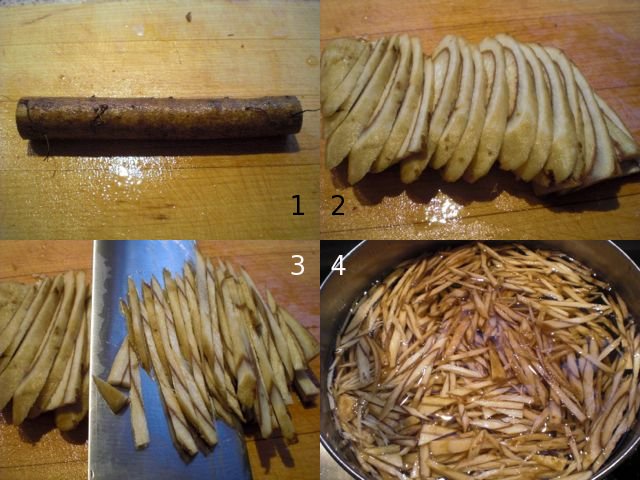
While I was holding (with pressure) the burdock slices at the 1 inch or so on the left side of the blade (since the slices are properly layered, the portion the knife was cutting would stay put. When the knife blade came very close to my fingers holding the slices of burdock, I stopped and moved my fingers to one inch further to the left and continues (#3, I did not have a photographer - my wife- available, so I could not take a picture in action). The julienned burdock was promptly soaked in acidulated water (#4). I soaked it or 5-10 minutes and washed it in cold running water and drained.
Carrot: I sliced and julienned carrot similar to the way I prepared burdock (1 small).
First dressing: I cooked burdock and carrot in salted boiling water with a dash of rice vinegar for 3-4 minutes. I then drained and mixed in the first dressing while it was hot (to add "shita-aji" 下味 or base flavor) consisting of rice vinegar (1 tbs), olive oil (1.5 tbs) seasoned with salt and pepper. I let it cool in the dressing to room temperature.
Meanwhile I prepared the pork and cucumber.
Carrot: I sliced and julienned carrot similar to the way I prepared burdock (1 small).
First dressing: I cooked burdock and carrot in salted boiling water with a dash of rice vinegar for 3-4 minutes. I then drained and mixed in the first dressing while it was hot (to add "shita-aji" 下味 or base flavor) consisting of rice vinegar (1 tbs), olive oil (1.5 tbs) seasoned with salt and pepper. I let it cool in the dressing to room temperature.
Meanwhile I prepared the pork and cucumber.
Pork: This was leftover roasted prok tenderloin, about 2 inch long (the dry rub consisting of black pepper, smoked paprika, cumin, cinnamon, clove, and salt) and rosted at 350F for 30 minutes, sliced and then julienned.
Cucumber: My usual American minicucu (1 ), sliced and then julienned. I salted and squeezed out the excess moistre.
Final dressing: I drained any excess liquid/the first dressing from the burdock mixture and dressed. The final dressing is a mixture of store bought mayonnaise (1.5 tbs) and plain yogurt (1 tbs) (this makes the mayo a bit less deadly). After tasting, I added more black pepper but no salt.
I set asided a small portion of the julienne of the pork and cucumber for garnish.
This is a dish which goes well with wine. The cookbook I have, called "Japanese Dishes for Wine Lovers" has their version of gobou salad and the recommeded wines are Beaujolais or Chion. Since I am not a big fan of "light" reds, I will go with more heavy reds like syrah or cab but even assertive white like oaky California Chardonnay will also work.
Actually, we were having this with an excellent and very unusual red from Douro, Portugal called Quinta Do Crasto 2009. The grapes used in this wine are supposedly from 70 year old low yielding vines of many different grape varietals. WA gave 94 and WE 93. It is difficult to describe this wine but it is the likes of Orin Swift approach of everything but kitchen sink. I don't know how they can manage "field" selection of "20-30 different grapes" to come up with this well balanced red.
Like Xmas, cherry blossom occurs only once a year. And as my wife's grandmother used to say, "There is nothing more over than Christmas", so with hanami. So, until next spring, we have to wait.
Saturday, March 24, 2012
Hanami continues; Japanese pancake with sakura ebi dried shrimp 桜海老、にら入り葱やき
This was an ending "shime" 〆 dish for our impromptu Hanami 花見. Because the weather has been quite warm, in our herb garden, garlic chives started poking out. With a short ceremony we conducted the first harvest of the year. Since I had these fresh home grown garlic chives or "nira" ニラ, I decided to make this "starchy" pancake as an ending dish. This is a sort of Japanese style savory pancake or Johnny cake.

This is also considered as a type of "okonomiyaki" お好み焼き and anything goes but this was what I made.
 I added dark sesame oil (1 tbs) in a non-stick frying pan on medium-low heat and spooned enough of the batter mixture to make several oval pancakes a few inches wide . After one side was set and browned (1 minute or so) , I flipped it over and cooked the other side (one more minute). I flipped it again and brushed on soy sauce. I flipped it several more times until both sides were coated with soy sauce and the soy sauce became fragrant. Obviously I overcooked it and my pancakes got a bit too dark.
I added dark sesame oil (1 tbs) in a non-stick frying pan on medium-low heat and spooned enough of the batter mixture to make several oval pancakes a few inches wide . After one side was set and browned (1 minute or so) , I flipped it over and cooked the other side (one more minute). I flipped it again and brushed on soy sauce. I flipped it several more times until both sides were coated with soy sauce and the soy sauce became fragrant. Obviously I overcooked it and my pancakes got a bit too dark.
Batter: I used a mixture of AP (all purpose) flour (3 tbs) and finely milled rice flour or "jou-shinko" 上新粉* (2 tbs).
*Rice flour can be rather coarsely ground (which I use for a dredging to deep fry or "karaage" 唐揚げ to make the crust crisper) or finely milled like this one called "Joushinko". This finely milled rice flour is usually used to make Japanese sweets as you can see on the pictures of this package on the left. Adding the rice flour to the batter will give the end product a more elastic texture or "mochi-mochi" mouth feel as Japanese would say. This is optional and you could use only wheat flour for this dish or if you are in gluten avoidance mode, use 100% rice flour.
I mixed in a beaten egg (one large), and chicken stock (or water or dashi) (about 4 tbs) to make a batter similar in consistency of regular pancake batter.
Vegetables: I cut the garlic chives into 1 inch segments (about 1/4 cup or whatever amount I harvested) and scallions (3, sliced on slant including the green parts).
Dried shrimp: I could have used chopped up shrimp or other forms of protein but I decided to use dried (and frozen) "Sakura-ebi" 桜海老 or cherry blossom shrimp (about 4 tbs). For one thing, I used them without thawing which was much easier than thawing regular shrimp and cutthing them up. These shrimp are also appropriate for cherry blossom gazing.
I mixed them all together and seasoned with soy sauce (about 1 tsp) and mirin (2-3 tsp).
Our garlic chives, first harvest, were nicely tender. With rather strong tasting sakura-ebi, the combination of garlic chives and scallion went well. For most people, this dish may not have been enough but we were quite full at this point. By the time we finished this dish, it was getting dark and cold. We retreated indoors, turned on the outside flood lights and kept admiring the cherry blossoms.
Subscribe to:
Posts (Atom)






